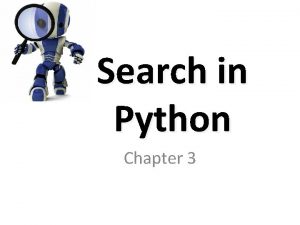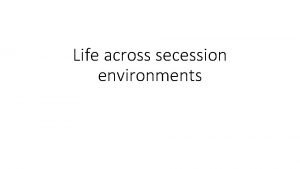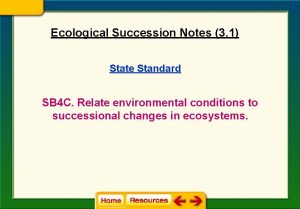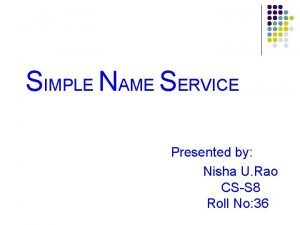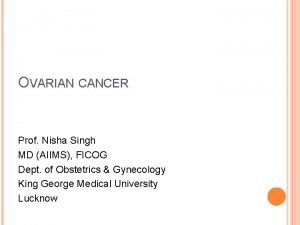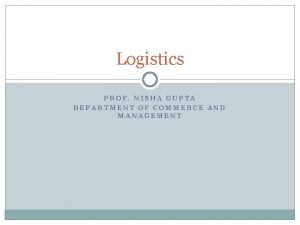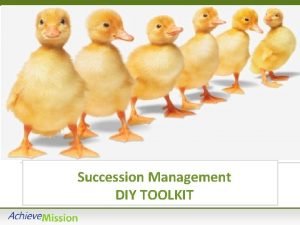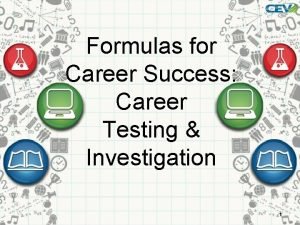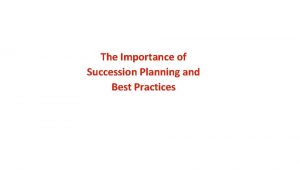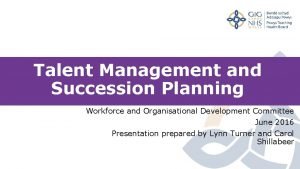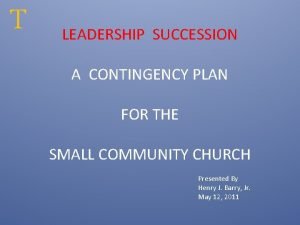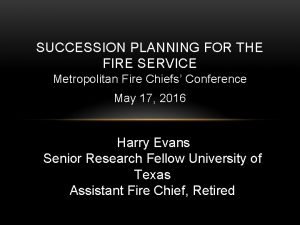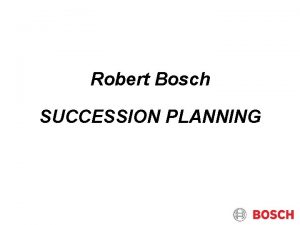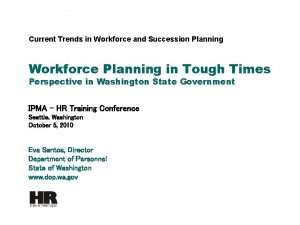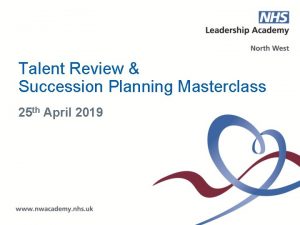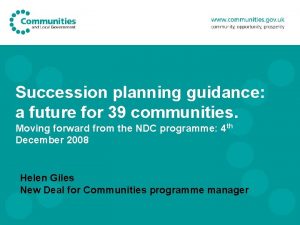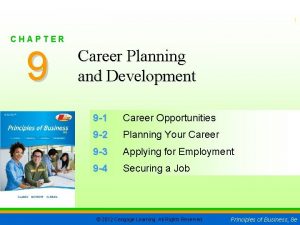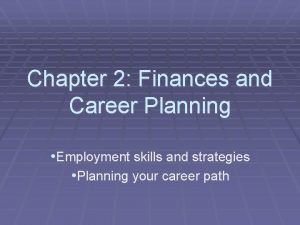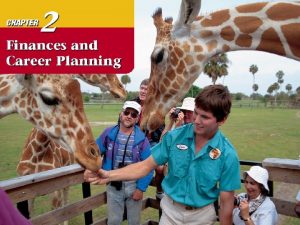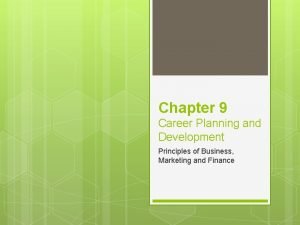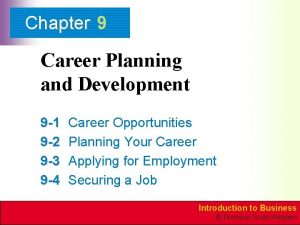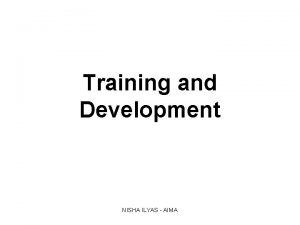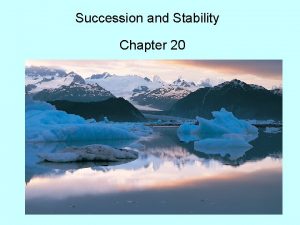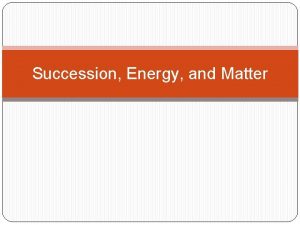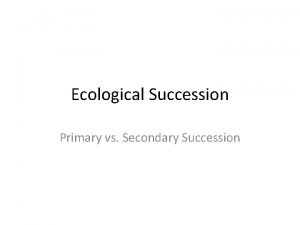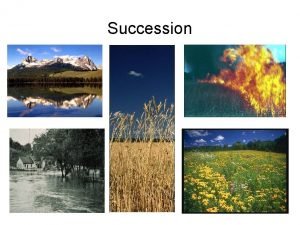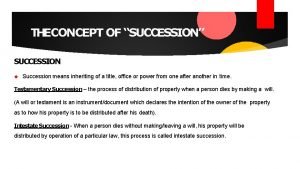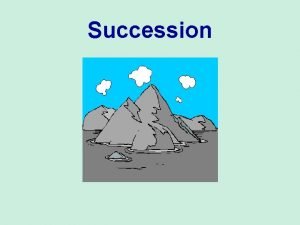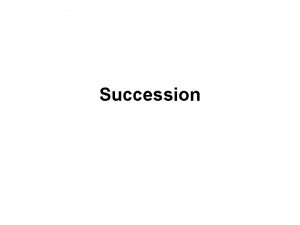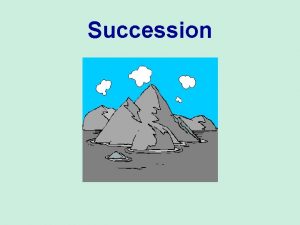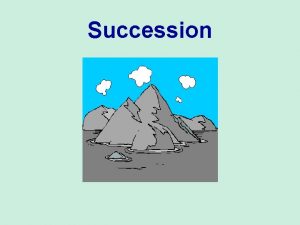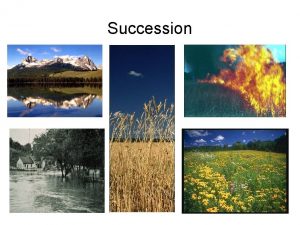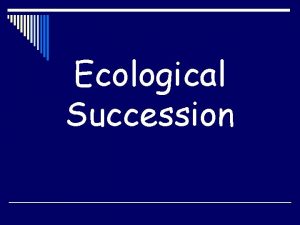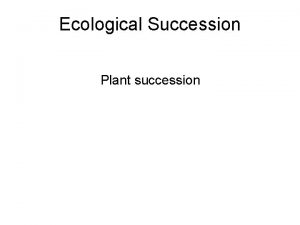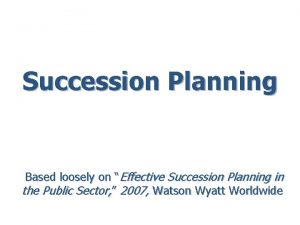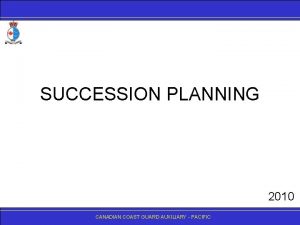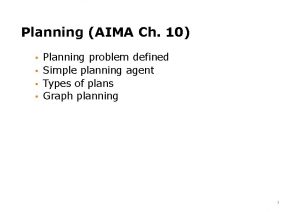CAREER PLANNING AND SUCCESSION PLANNING NISHA AIMA The
























































- Slides: 56

CAREER PLANNING AND SUCCESSION PLANNING NISHA - AIMA

The Basics of Career Management Ø Career – The occupational positions a person has had over many years. – A career comprises of a series of work related activities, that offer continuity, order and meaning to a person’s life. NISHA - AIMA

CAREERS – IMPORTANT FEATURE v A career develops over time v The success of one's career depends, most often, on one's own careful planning and timely steps taken at a right time v The important element in one's career is experiencing psychological success. The typical career of a person today would probably include many positions and transitions. NISHA - AIMA

The Basics of Career Management Ø Career management – The process for enabling employees to better understand develop their career skills and interests, and to use these skills and interests more effectively. Ø Career development – The lifelong series of activities that contribute to a person’s career exploration, establishment, success, and fulfillment. NISHA - AIMA

The Basics of Career Management Ø Career planning – The deliberate process through which someone becomes aware of personal skills, interests, knowledge, motivations, and other characteristics; and establishes action plans to attain specific goals. Ø Careers today – Careers are no simple progressions of employment in one or two firms with a single profession. – Employees now want to exchange performance for training, learning, and development that keep them marketable. NISHA - AIMA

Traditional Vs Career Development Focus Source: Adapted from Fred L. Otte and Peggy G. Hutcheson, Helping Employees Manage Careers (Upper Saddle River, NJ: Prentice Hall, 1992), p. 10. NISHA - AIMA Table 10– 1

Employee Career Development Plan NISHA - AIMA Source: Reprinted with permission of the publisher, HRnext. com Copyright HRnext. com, 2003.

Roles in Career Development The Individual The Organization • Accept responsibility for your own career. • Assess your interests, skills, and values. • Seek out career information and resources. • Establish goals and career plans. • Utilize development opportunities. • Talk with your manager about your career. • Follow through on realistic career plans. The Manager • Communicate mission, policies, and procedures. • Provide training and development opportunities. • Provide career information and career programs. • Offer a variety of career options. • Provide timely performance feedback. • Provide developmental assignments and support. • Participate in career development discussions. • Support employee development plans. NISHA - AIMA Source: Fred L. Otte and Peggy G. Hutcheson, Helping Employees Manage Careers (Upper Saddle River, NJ: Prentice Hall, 1992), p. 56.

Choosing a Mentor Ø Choose an appropriate potential mentor. Ø Don’t be surprised if you’re turned down. Ø Be sure that the mentor understands what you expect in terms of time and advice. Ø Have an agenda. Ø Respect the mentor’s time. NISHA - AIMA

The Employer’s Role in Career Development Ø Realistic job previews Ø Challenging first jobs Ø Career-oriented appraisals Ø Job rotation Ø Mentoring Ø Networking and interactions NISHA - AIMA

Innovative Corporate Career Development Initiatives Ø Provide each employee with an individual budget. Ø Offer on-site or online career centers. Ø Encourage role reversal. Ø Establish a “corporate campus. ” Ø Help organize “career success teams. ” Ø Provide career coaches. Ø Provide career planning workshops Ø Utilize computerized on- and offline career development programs Ø Establish a dedicated facility for career development NISHA - AIMA

Managing Promotions Ø Making promotion decisions – – Decision 1: 2: 3: 4: Is Seniority or Competence the Rule? How Should We Measure Competence? Is the Process Formal or Informal? Vertical, Horizontal, or Other? NISHA - AIMA

Managing Transfers Ø Employees’ reasons for desiring transfers – – Personal enrichment and growth More interesting jobs Greater convenience (better hours, location) Greater advancement possibilities Ø Employers’ reasons for transferring employees – To vacate a position where an employee is no longer needed. – To fill a position where an employee is needed. – To find a better fit for an employee within the firm. – To boost productivity by consolidating positions. NISHA - AIMA

Enhancing Diversity through Career Management Ø Sources of bias and discrimination in promotion decisions – Having few people of color employed in the hiring department – The “old-boy network” of informal friendships – A lack of women mentors – A lack of high-visibility assignments and developmental experiences (glass ceiling) – A lack of company role models for members of the same racial or ethnic group – Inflexible organizations and career tracks NISHA - AIMA

Enhancing Women’s and Minorities’ Prospects Ø Eliminate institutional barriers Ø Improve networking and mentoring Ø Eliminate the glass ceiling Ø Institute flexible schedules and career tracks NISHA - AIMA

Career Management and Employee Commitment Ø The “New Psychological Contract” – Old contract: “Do your best and be loyal to us, and we’ll take care of your career. ” – New contract: “Do your best for us and be loyal to us for as long as you’re here, and we’ll provide you with the developmental opportunities you’ll need to move on and have a successful career. ” NISHA - AIMA

Career Management and Employee Commitment Ø Commitment-oriented career development efforts – Career development programs • Career workshops that use vocational guidance tools (including a computerized skills assessment program and other career gap analysis tools) to help employees identify career-related skills and the development needs they possess. – Career-oriented appraisals • Provide the ideal occasion to link the employee’s performance, career interests, and developmental needs into a coherent career plan. NISHA - AIMA

Retirement Ø Retirement – The point at which one gives up one’s work, usually between the ages of 60 and 65. Ø Pre-retirement practices – – – – Explanation of Social Security benefits Leisure time counseling Financial and investment counseling Health counseling Psychological counseling Counseling for second careers inside the company NISHA - AIMA

Identify Your Career Stage Ø Growth stage Ø Exploration stage Ø Establishment stage – Trial substage – Stabilization substage – Midcareer crisis substage Ø Maintenance Stage Ø Decline Stage NISHA - AIMA

Career stages NISHA - AIMA

Identify Your Occupational Orientation Ø Realistic orientation Ø Investigative orientation Ø Social orientation Ø Conventional orientation Ø Enterprising orientation Ø Artistic orientation NISHA - AIMA

Choosing an Occupational Orientation Figure 10–A 1 NISHA - AIMA

Example of Some Occupations that May Typify Each Occupational Theme Figure 10–A 2 NISHA - AIMA

Identify Your Career Anchors Ø Career anchor – A concern or value that as person you will not give up if a [career] choice has to be made. Ø Typical career anchors – – – Technical/functional competence Managerial competence Creativity Autonomy and independence Security NISHA - AIMA

Finding the Right Job Ø Do Your Own Local Research Ø Personal Contacts Ø Answering Advertisements Ø Employment Agencies Ø Executive Recruiters Ø Career Counselors Ø Employers’ Web Sites NISHA - AIMA

Writing Your Résumé Ø Introductory Information Ø Job Objective Ø Job Scope Ø Your Accomplishments Ø Length Ø Personal Data Ø Make Your Résumé Scannable NISHA - AIMA

Handling the Interview Ø Prepare, Prepare Ø Uncover the Interviewer’s Needs Ø Relate Yourself to the Person’s Needs Ø Think Before Answering Ø Make a Good Appearance and Show Enthusiasm NISHA - AIMA

Career Planning Ø Career planning implies helping the employees to plan his or her career in terms of his or her capabilities within the context of org. needs Ø Career planning is the process by which one selects career goals and the path to achieve those goals. Ø Career planning does not imply: – predicting / envisaging / ensuring higher positions for each employee oraganisational realities growth or progression – opportunities at different place is different – pyramidal hierarchy can not create many positions – uniform rate of progression not possible in all depts / units NISHA - AIMA

Components of Career Planning Organisation Design & HR Plans Corporate Plans Career Plannin g Development Opportunities Promotion Policy NISHA - AIMA Career Paths / Role Requirements Performance Appraisal / Potential Appraisal

Need for Career Planning is necessary due to the following reasons: ØTo attract competent persons & to retain them ØTo provide suitable promotional opportunities. ØTo enable the employees to develop & make them ready to meet the future challenges. ØTo increase the utilization of managerial reserves within an organization. ØTo correct employee placement. ØTo reduce employee dissatisfaction and turnover. ØTo improve motivation and morale. NISHA - AIMA

Process of Career Planning & Development Ø Analysis of individual skills, knowledge, abilities, aptitudes etc. Ø Analysis of career opportunities both within and outside the organization. Ø Analysis of career demands on the incumbent in terms of skills, knowledge, abilities, aptitude etc. , and in terms of qualifications, experience and training received etc. Ø Relating specific jobs to different career opportunities. Ø Establishing realistic goals both short-term and long-term. Ø Formulating career strategy covering areas of change and adjustment. Ø Preparing and implementing action plan including acquiring resources for achieving goals. NISHA - AIMA

Steps involved in Career Development System Ø Step 1: Needs: Defining the present system Ø Establish roles and responsibilities of employees, managers, and the organization. Ø Identify needs; establish target groups. Ø Establish cultural parameters; determine organizational receptivity, support, and commitment to career development. Ø Assess existing HR Programme or structure; consider possible links to a career development programme. Ø Determine prior attempts at solving the problem or need. Ø Establish the mission or philosophy of the programme. Ø Design and implement needs assessment to confirm the data or collect more data. Ø Establish indicators or criteria of success. NISHA - AIMA

Steps involved in Career Development System Ø Ø Step 2: Vision: Determining New Directions & Possibilities Create a long-term philosophy. Establish the vision or objectives of the programme. Design interventions for employees, managers, and the organization. Organize and make available career information needed to support the programme. NISHA - AIMA

Steps involved in Career Development System Step 3: Action Plan: Deciding on practical first steps Ø Assess the plan and obtain support from top management Ø Create a pilot programme Ø Assess resources and competencies. Ø Establish an advisory group. Ø Involve advisory group in data gathering, programme design, implementation, evaluation and monitoring NISHA - AIMA

Steps involved in Career Development System Step 4: Results: Maintaining the change Ø Create long-term formalized approaches. Ø Publicize the programme. Ø Evaluate and redesign the programme and its components. Ø Consider future trends and directions for the programme. NISHA - AIMA

Pre-requisites for the success of career planning Ø Strong commitment of the top management in career planning, succession planning and development. Ø Organization should develop, expand diversify its activities at a phased manner. Ø Organization should frame clear corporate goals. Ø Organization should have self-motivated, committed and hard working employees. Ø Organization’s goal in selection should be selecting the most suitable man and place him in the right job. Ø Organization should take care of the proper age composition in manpower planning and in selection. Ø Organization should take steps to minimize career stress. Ø Organization should have fair promotion policy. Ø Organization should publicize widely the career planning and development programmes NISHA - AIMA

Advantages of Career Planning & Development For Individuals Ø The process of career planning helps the individual to have the knowledge of various career opportunities, his priorities etc. Ø This knowledge helps him select the career that is suitable to his life styles, preferences, family environment, scope for selfdevelopment etc. Ø It helps the organization identify internal employees who can be promoted. Ø Internal promotions, upgradation and transfers motivate the employees, boost up their morale and also result in increased job satisfaction. Ø Employee will await his turn of promotion rather than changing to another organization. This will lower employee turnover. Ø It improves employee’s performance on the job by taping their potential abilities and further employee turnover. Ø It satisfies employee esteem needs. NISHA - AIMA

Advantages of Career Planning & Development Ø For Organizations Ø Efficient career planning and development ensures the availability of human resources with required skill, knowledge and talent. Ø The efficient policies and practices improve the organization’s ability to attract and retain highly skilled and talent employees. Ø The proper career planning ensures that the women and people belong to backward communities get opportunities for growth and development. Ø The career plan continuously tries to satisfy the employee expectations and as such minimizes employee frustration. Ø By attracting and retaining the people from different cultures, enhances cultural diversity. Ø Protecting employees’ interest results in promoting organizational goodwill. NISHA - AIMA

Limitations of career planning Despite planning the career, employees face certain career problems. They are: ØDual Career Families ØLow ceiling careers ØDeclining Career Opportunities ØDownsizing/Delayering and careers NISHA - AIMA

Suggestions for effective career development Ø Ø Ø Challenging Initial Job Assignments Dissemination of Career Option Information Job Positioning Assessment Centres Career Counseling NISHA - AIMA

Succession Planning Ø Succession planning is a process whereby an organization ensures that employees are recruited and developed to fill each key role within the company. Ø Through your succession planning process, you recruit superior employees, develop their knowledge, skills, and abilities, and prepare them for advancement or promotion into ever more challenging roles. NISHA - AIMA

Continuous Change at Nokia has continually adapted to its changing environment. The Finnish company began as a pulp and paper mill in Courtesy National Board of Antiquities, Finland 1865, then moved into rubber, cable wiring, and computer monitors. In the 1980 s, Nokia executives sensed an emerging market for wireless communication. Today, Nokia is a world leader in cellular telephones.

Changing People: Some Basic Steps Step 3: Refreezing Incorporating the changes, creating and maintaining a new organizational system Step 2: Changing Attempting to create a new state of affairs Step 1: Unfreezing Recognizing the need for change Cu t n e rr te a t S e w Ne t a t S

When Will It Occur? If benefits exceed costs Change is made Amount of dissatisfaction with current conditions Availability of a desirable alternative Existence of a plan for achieving a desirable alternative Benefit of making change Compared to Cost of making change Change is not made If costs exceed benefits

Forces for Change Globalization & Competition Information Technology Demography

Resistance to Change Direct Costs Saving Face Forces for Change Fear of the Unknown Breaking Routines Incongruent Systems Incongruent Team Dynamics

Creating an Urgency for Change Ø Need to motivate employees to change Ø Most difficult when organisation is doing well Ø Must be real, not contrived Ø Customer-driven change – Adverse consequences for firm – Human element energizes employees

Minimizing Resistance to Change Communication Coercion Negotiation Training Minimizing Resistance to Change Stress Management Employee Involvement

Refreezing the Desired Conditions Creating organizational systems and team dynamics to reinforce desired changes – alter rewards to reinforce new behaviours – new information systems guide new behaviours – recalibrate and introduce feedback systems to focus on new priorities

Change Agents Ø Anyone who possesses enough knowledge and power to guide and facilitate the change effort Ø Change agents apply transformational leadership – – Help develop a vision Communicate the vision Act consistently with the vision Build commitment to the vision

Successfully Diffusing Change Ø Ø Ø Successful pilot study Favourable publicity Top management support Labour union involvement Diffusion strategy described well Pilot program people moved around

Organization Development Defined A planned system wide effort, managed from the top with the assistance of a change agent, that uses behavioural science knowledge to improve organizational effectiveness.

Action Research Process Establish Client. Consultant Relations Diagnose Need for Change Introduce Change Evaluate/ Stabilize Change Disengage Consultant’s Services

Appreciative Inquiry Process Discovery Dreaming Designing Delivering Discovering the best of “what is” Forming ideas about “what might be” Engaging in dialogue about “what should be” Developing objectives about “what will be”

Organization Development Concerns Ø Cross-Cultural Concerns – Linear and open conflict assumptions different from values in some cultures Ø Ethical Concerns – – Management power Employee privacy rights Employee self-esteem Consultant’s role

The Ethics of OD: Summary of the Debate OD is ethical OD is unethical • Imposes values of the organization; coercive and manipulative • Potential for abuse • The imposition of values is an inherent part of life, especially on the job • Abuse comes from individuals, not from the technique itself, which is neither good nor evil
 Agent aima
Agent aima Propositional logic in ai ppt
Propositional logic in ai ppt Aima python
Aima python Ecological succession succession of a pond
Ecological succession succession of a pond Ecological succession succession of a pond
Ecological succession succession of a pond Anisha patel family feud
Anisha patel family feud Name of technique
Name of technique Dr nisha patel
Dr nisha patel Nisha nagarajan
Nisha nagarajan Nisha patel md
Nisha patel md Nisha patel md
Nisha patel md Nisha singh md
Nisha singh md Nisha patel md
Nisha patel md Nisha rughwani
Nisha rughwani Talent management toolkit
Talent management toolkit National fcs standards
National fcs standards Formulas for career success career testing & investigation
Formulas for career success career testing & investigation Board succession planning best practices
Board succession planning best practices Cipd succession planning
Cipd succession planning Church leadership succession planning
Church leadership succession planning Succession
Succession Diversified succession plan
Diversified succession plan Types of succession planning
Types of succession planning Cottage succession planning
Cottage succession planning Succession planning definition
Succession planning definition Succession planning trends
Succession planning trends Talent review succession planning
Talent review succession planning Succession planning guidance
Succession planning guidance Chapter 9 career planning and development
Chapter 9 career planning and development Chapter 4 finances and career planning
Chapter 4 finances and career planning Chapter 2 finances and career planning
Chapter 2 finances and career planning Personal finance unit 1
Personal finance unit 1 Chapter 9 career planning and development
Chapter 9 career planning and development Chapter 9 career planning and development
Chapter 9 career planning and development Hình ảnh bộ gõ cơ thể búng tay
Hình ảnh bộ gõ cơ thể búng tay Bổ thể
Bổ thể Tỉ lệ cơ thể trẻ em
Tỉ lệ cơ thể trẻ em Gấu đi như thế nào
Gấu đi như thế nào Chụp tư thế worms-breton
Chụp tư thế worms-breton Alleluia hat len nguoi oi
Alleluia hat len nguoi oi Kể tên các môn thể thao
Kể tên các môn thể thao Thế nào là hệ số cao nhất
Thế nào là hệ số cao nhất Các châu lục và đại dương trên thế giới
Các châu lục và đại dương trên thế giới Công thức tính độ biến thiên đông lượng
Công thức tính độ biến thiên đông lượng Trời xanh đây là của chúng ta thể thơ
Trời xanh đây là của chúng ta thể thơ Mật thư tọa độ 5x5
Mật thư tọa độ 5x5 Làm thế nào để 102-1=99
Làm thế nào để 102-1=99 độ dài liên kết
độ dài liên kết Các châu lục và đại dương trên thế giới
Các châu lục và đại dương trên thế giới Thơ thất ngôn tứ tuyệt đường luật
Thơ thất ngôn tứ tuyệt đường luật Quá trình desamine hóa có thể tạo ra
Quá trình desamine hóa có thể tạo ra Một số thể thơ truyền thống
Một số thể thơ truyền thống Cái miệng bé xinh thế chỉ nói điều hay thôi
Cái miệng bé xinh thế chỉ nói điều hay thôi Vẽ hình chiếu vuông góc của vật thể sau
Vẽ hình chiếu vuông góc của vật thể sau Thế nào là sự mỏi cơ
Thế nào là sự mỏi cơ đặc điểm cơ thể của người tối cổ
đặc điểm cơ thể của người tối cổ


